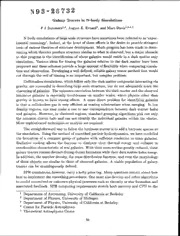
NASA Technical Reports Server (NTRS) 19930017543: Galaxy tracers in N-body simulations PDF
Preview NASA Technical Reports Server (NTRS) 19930017543: Galaxy tracers in N-body simulations
Galaxy Tracers in N-body Simulations F J Summers1'4, August E. Evrard2, and Marc Davis1'3'4'5 N-body simulations of large scale structure have sometimes been referred to as 'exper- imental cosmology'. Indeed, at the heart of these efforts is the desire to provide stringent tests of various theories of structure development. Much progress has been made in deter- mining which theories produce structure similar to what is observed, but a major obstacle to this progress is the identification of where galaxies would reside in a dark matter only 'simulation. Various ideas for biasing the galaxies relative to the dark matter have been proposed and these schemes provide a large amount of flexibility when comparing simula- tion and observation. Developing a well defined, reliable galaxy tracer method that would cut through the veil of biasing is an important, but complex problem. Collisionless simulations, which follow only the dark matter component interacting via gravity, are successful in describing large scale structure, but do not adequately track the clustering of galaxies. The unknown correlation between the dark matter and the observed luminous galaxies is especially troublesome on smaller scales, where physics other than gravity is known to have strong effects. A more direct problem for identifying galaxies is that a collisionless gas is very efficient at erasing substructure when merging. In low density regions, one may make a one to one correspondence between dark matter halos and galaxies. However, in clustered regions, standard grouping algorithms pick out only the common cluster halo and can not identify the individual galaxies within the cluster. More sophisticated techniques or analysis are required. The straightforward way to follow the luminous matter is to add a baryonic species to the simulation. Using the method of smoothed particle hydrodynamics, we have modelled the formation of a compact group of galaxies with sufficient resolution to trace galaxies. Radiative cooling allows the baryons to dissipate their thermal energy and collapse to overdensities characteristic of real galaxies. With their cross section greatly reduced, these galaxy tracers remain distinct during cluster formation while their dark matter halos merge. In addition, the number density, the mass distribution function, and even the morphology of these objects are similar to those of observed galaxies. A viable population of galaxy tracers can be unambiguously defined. SPH simulations, however, carry a hefty price tag. Many questions remain about how best to implement the smoothing procedures. One must also develop and refine algorithms to model unresolved or unknown physical processes such as viscosity or star formation and associated feedback. SPH computing requirements stretch both memory and CPU to the 1 Department of Astronomy, University of California at Berkeley 2 Department of Physics, University of Michigan 3 Department of Physics, University of California at Berkeley 4 Center for Particle Astrophysics 5 Theoretical Astrophysics Center 56 limits on even the biggest supercomputers. In addition, there is evidence that the mass resolution necessary to achieve sufficient cooling and form galaxy tracers may limit current simulations to box sizes too small to make adequate measurements of large scale structure. Simpler methods for tracing galaxies are desirable and these ideas can be checked for consistency with the SPH results. One method we have investigated is to try to follow galaxy tracers through the merging process in a collisionless only simulation. The idea is that one can tag individual halos before merging and then later examine these particles within the cluster halo to identify galaxy tracers. Utilizing a collisionless only simulation with the same initial conditions as our collisionless plus SPH model, two algorithms have been studied. Neither method finds enough substructure within the cluster halo, especially in the central region. In fact, most of the groups of particles identified are not gravitationally bound. These results disagree with the findings of Carlberg, Couchman, and Thomas chiefly because the baryons in their SPH simulation, due to insufficient mass resolution, did not cool and collapse to the very high overdensities we observe. Our results support the notion that collisionless galaxy tracer algorithms will always fail due to the fact that groups of collisionless particles lack a dissipational mechanism for maintaining spatial and kinetic coherence during merging. Methods of tracing galaxies should be devised, extended, and examined carefully. A star formation algorithm is being developed and tested for inclusion in the SPH code. Perhaps a suitable collisionless tracer mechanism can be found, though the current .results. are not encouraging. Collisionless n-body codes have been successfully coupled to Eulerian (grid based) hydrodynamics codes, but fixed grid hydrodynamics simulations do not yet have the dynamic range necessary to resolve galaxies within clusters and there is little a priori knowledge of where to place a refined grid. Having the SPH results in hand, one may be able to modify collisionless codes to mimic the cooling processes via an expert system. Such techniques may yield good results in the future. For the present, one concludes that SPH methods, though costly, are required to reliably trace galaxies in simulations. 57
